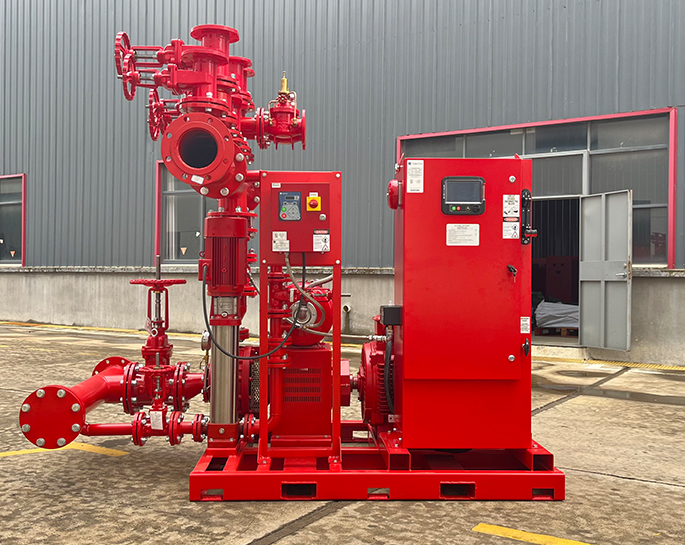What role does the suction pipe play in a fire pump system, and are there specific requirements for its design?
Jan 25, 2024
Share:
The suction pipe is a critical component in a fire pump system, playing a key role in drawing water from a water source (such as a tank, reservoir, or other water supply) to the fire pump. The design and installation of the suction pipe are crucial to ensure the efficient and reliable operation of the fire pump system. Here are the main roles and specific requirements for the design of the suction pipe:
**Role of the Suction Pipe:**
1. **Water Supply:** The suction pipe is responsible for drawing water from the water source to the fire pump. This is essential for providing an adequate water supply to the fire protection system.
2. **Preventing Air Entrapment:** One of the primary challenges in suction pipe design is to prevent air from entering the system. Air entrainment can lead to cavitation, causing damage to the pump and affecting its efficiency. Proper design and installation help minimize the risk of air being drawn into the suction pipe.
3. **Avoiding Vortex Formation:** Vortex formation can occur at the water surface in the suction source, leading to air being introduced into the system. Suction pipe design should prevent vortexing, which is typically achieved through the use of proper suction pipe length, diameter, and configuration.
**Requirements for Suction Pipe Design:**
1. **Size and Diameter:** The size and diameter of the suction pipe should be carefully selected to match the requirements of the fire pump. The pipe should be large enough to provide sufficient flow to the pump without causing excessive friction losses.
2. **Length and Straight Runs:** The length of the suction pipe and the presence of straight runs are important considerations. Ideally, the suction pipe should be as short as possible and have straight sections leading to the pump. This helps minimize friction losses and turbulence in the pipe.
3. **Depth of Submergence:** The suction pipe should be submerged below the water surface to prevent vortex formation and air entrainment. The depth of submergence is a critical factor in ensuring the pump draws water efficiently.
4. **Suction Lift:** If the water source is below the pump, the suction lift should be within acceptable limits. Suction lift is the vertical distance between the water surface and the pump's centerline. Excessive suction lift can lead to cavitation.
5. **Strainers and Filters:** To prevent debris from entering the pump and causing damage, strainers and filters should be installed on the suction side of the system. These components need to be regularly inspected and cleaned.
6. **Anti-Vortex Plate:** In some cases, an anti-vortex plate may be installed at the water surface to prevent vortexing and air entrainment.
Compliance with industry standards and guidelines, such as those provided by the National Fire Protection Association (NFPA), is crucial when designing and installing suction pipes for fire pump systems. Regular inspection, testing, and maintenance of the entire fire pump system, including the suction pipe, are essential to ensure its reliability during an emergency.

**Role of the Suction Pipe:**
1. **Water Supply:** The suction pipe is responsible for drawing water from the water source to the fire pump. This is essential for providing an adequate water supply to the fire protection system.
2. **Preventing Air Entrapment:** One of the primary challenges in suction pipe design is to prevent air from entering the system. Air entrainment can lead to cavitation, causing damage to the pump and affecting its efficiency. Proper design and installation help minimize the risk of air being drawn into the suction pipe.
3. **Avoiding Vortex Formation:** Vortex formation can occur at the water surface in the suction source, leading to air being introduced into the system. Suction pipe design should prevent vortexing, which is typically achieved through the use of proper suction pipe length, diameter, and configuration.
**Requirements for Suction Pipe Design:**
1. **Size and Diameter:** The size and diameter of the suction pipe should be carefully selected to match the requirements of the fire pump. The pipe should be large enough to provide sufficient flow to the pump without causing excessive friction losses.
2. **Length and Straight Runs:** The length of the suction pipe and the presence of straight runs are important considerations. Ideally, the suction pipe should be as short as possible and have straight sections leading to the pump. This helps minimize friction losses and turbulence in the pipe.
3. **Depth of Submergence:** The suction pipe should be submerged below the water surface to prevent vortex formation and air entrainment. The depth of submergence is a critical factor in ensuring the pump draws water efficiently.
4. **Suction Lift:** If the water source is below the pump, the suction lift should be within acceptable limits. Suction lift is the vertical distance between the water surface and the pump's centerline. Excessive suction lift can lead to cavitation.
5. **Strainers and Filters:** To prevent debris from entering the pump and causing damage, strainers and filters should be installed on the suction side of the system. These components need to be regularly inspected and cleaned.
6. **Anti-Vortex Plate:** In some cases, an anti-vortex plate may be installed at the water surface to prevent vortexing and air entrainment.
Compliance with industry standards and guidelines, such as those provided by the National Fire Protection Association (NFPA), is crucial when designing and installing suction pipes for fire pump systems. Regular inspection, testing, and maintenance of the entire fire pump system, including the suction pipe, are essential to ensure its reliability during an emergency.


.png)
.png)

.png)


